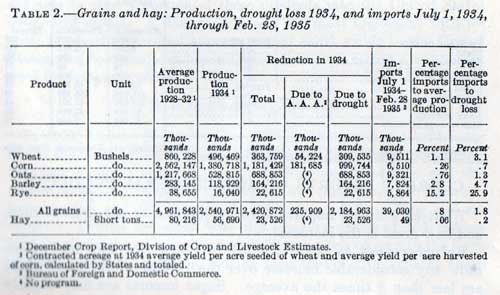Current Imports, Relative Volume, Corn Imports (1935)
The Drought and Current Farm Imports - 1935 - Section 2
Section two from the 1935 Booklet Issued by the WPA covers topics on the increases on agricultural and other imports and a comparison of current import levels to historical and relative import levels.
Current Imports of Agricultural Products
What agricultural imports show an increase at the present time, and how great is the increase?
Referring again to table 1, it will be noted that only feed grains show any considerable increase over the 10-year average, and these are less than 3 times the average.
Sugar imports are only slightly higher; all other products show a decrease in imports in relation to the 10-year average. Sugar imports, it may be noted, are regulated by quota arrangements in accordance with the Jones-Costigan Sugar Act approved May 9, 1934.
Meat imports were 17 percent less than the 10-year average; vegetable oils, 14 percent less; fruits, omitting bananas, 25 percent less; wool, 56 percent under; vegetables, 51 percent under; dairy foods, 61 percent under; and eggs and egg products, 78 percent less than the 10-year average imports.
Imports of all competitive agricultural products were 75 percent of the 10-year average. Imports of noncompetitive agricultural products (coffee, tea, rubber, etc.) were 99 percent of the 10-year average.
Thus only imports of grains showed a considerable increase over the average for the previous 10 years. Production of grains in 1934, because of the drought, was cut down more than production of other agricultural products.
Relative Volume of Current Imports of Grains
While imports of grains during recent months are large in comparison to imports during previous years, a true picture of their importance can be obtained only by comparing the quantities that are coming over tariff walls with the total amounts produced and consumed in the United States, with exports, and with the loss caused by the 1934 drought.
Table 2 indicates the size of grain and hay imports as compared with average production and with the losses caused by the drought. Current grain imports taken as a whole are only 1.8 percent of the loss to all grains due to the drought, estimated at over 2 billion bushels.
TABLE 2. Grains and hay: Production, drought loss 1934, and imports July 1, 1934, through February 28, 1935

- December crop Report, Division of Crop and Livestock Estimates.
- Contracted acreage et 1934 average yield per acre seeded of wheat and average yield per acre harvested of morn, calculated by States and totaled.
- Bureau of Foreign and Domestic Commerce.
- No program.
Imports of wheat for domestic consumption (which does not include bonded wheat imports for milling and re-export) during the 8-month period from July 1, 1934, through February 28, 1935, were 9,511,000 bushels.
This compares with an average production during the 5 years from 1928 through 1932 of 860 million bushels, or less than 1 percent. Drought damage to the wheat crop last year is estimated to have reduced production by about 300 million bushels, in addition to the reduction of 54 million bushels brought about by the Agricultural Adjustment Administration wheat program.
Wheat that has been imported since July 1, 1934, and through February 1935 has amounted to a little over 3 percent of the loss directly attributed to the drought.
Wheat exports during 1934 of more than 25 million bushels greatly exceeded imports of less than 8 million bushels during the same period. For January and February 1935 wheat imports about balanced exports.
Corn Imports Equal To Crop of One Iowa County
Corn imports during the same 8-month period were 6,510,000 bushels. The extent of corn imports may be judged by noting that 6,510,000 bushels is about equal to the production of a representative Iowa corn county—for example, Calhoun County—during an average year.
The same amount is about one-fourth of 1 percent of our average annual corn production of 2,500,000,000 bushels. Damage to the corn crop last year is estimated to have reduced the yield by approximately a billion bushels, while reduction through the 1934 corn-hog program is estimated at less than 200 million bushels. Thus corn imports during the 8-month period were about seven-tenths of 1 percent of the estimated drought loss.
While corn imports have increased since January 1, it should be noted that exports of corn during 1934, amounting to about 3 1/2 million bushels, were greater than imports of around 3 million bushels.
Imports of oats, barley, and rye were relatively larger than imports of corn and wheat. Oat imports were 9,321,000 bushels during the 8-month period, or 1.35 percent of the drought loss to this crop of about 700 million bushels. Barley imports were 7,824,000 bushels, or approximately 5 percent of the drought loss. Rye imports were 5,864,000 bushels, or about 26 percent of the 1934 reduction below the average rye crop.
Index to Part I of the Current Farm Imports 1935 Booklet
- Introduction, Export-Import Status, Imports in 1923
- Current Imports, Relative Volume and Corn Imports
- Adjustment of Oats, Barley, and Rye; Meat Imports; Slaughter of Animals
- Butter Imports, Reduction in Tariffs, Present Situation
- Should Imports be Prohibited, Export Basis, Agricultural Exports
- Exchange of Goods, AAA Programs, Livestock Programs
- Drought Shortages and Excess Crop Acreage

